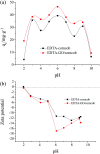Efficient removal of crystal violet dye using EDTA/graphene oxide functionalized corncob: a novel low cost adsorbent
- PMID: 35518863
- PMCID: PMC9066744
- DOI: 10.1039/c9ra04003j
Efficient removal of crystal violet dye using EDTA/graphene oxide functionalized corncob: a novel low cost adsorbent
Abstract
In this study, EDTA functionalized corncob (EDTA-corncob) and EDTA/graphene oxide functionalized corncob (EDTA-GO/corncob) were prepared using disodium ethylenediamine tetraacetic acid and the graphene oxide immersion method. EDTA-corncob and EDTA-GO/corncob were characterized by SEM and FTIR spectroscopy. On this basis, the adsorption properties of EDTA-corncob and EDTA-GO/corncob were studied with crystal violet as the adsorbate. The optimum adsorption conditions were determined by the effect of samples on the adsorption properties of crystal violet at different times, temperatures and pH, and the reusability of the samples was studied. The results showed that adsorption capacity of crystal violet on EDTA-GO/corncob was higher compared with natural corncob and EDTA-corncob. The most suitable pH value of the solution is about 6.0, the adsorption equilibrium time is 200 min. EDTA-GO/corncob can be reused eight times. This study indicated that EDTA-GO/corncob is a reusable adsorbent for rapid, low-cost, and efficient removal of dye from waste water.
This journal is © The Royal Society of Chemistry.
Conflict of interest statement
There are no conflicts to declare.
Figures










Similar articles
-
Adsorption behavior of isocyanate/ethylenediamine tetraacetic acid-functionalized graphene oxides for Cu2+ removal.Water Sci Technol. 2018 Dec;78(12):2459-2468. doi: 10.2166/wst.2018.520. Water Sci Technol. 2018. PMID: 30767911
-
A novel environmental-friendly nanobiocomposite synthesis by EDTA and chitosan functionalized magnetic graphene oxide for high removal of Rhodamine B: Adsorption mechanism and separation property.Chemosphere. 2019 Mar;218:715-725. doi: 10.1016/j.chemosphere.2018.11.109. Epub 2018 Nov 16. Chemosphere. 2019. PMID: 30504047
-
Study on Preparation of Chitosan/Polyvinyl Alcohol Aerogel with Graphene-Intercalated Attapulgite(GO-ATP@CS-PVA) and Adsorption Properties of Crystal Violet Dye.Nanomaterials (Basel). 2022 Nov 8;12(22):3931. doi: 10.3390/nano12223931. Nanomaterials (Basel). 2022. PMID: 36432217 Free PMC article.
-
Preparation of functionalized graphene oxide and its application as a nanoadsorbent for Hg(2+) removal from aqueous solution.Environ Monit Assess. 2016 Apr;188(4):223. doi: 10.1007/s10661-016-5226-2. Epub 2016 Mar 11. Environ Monit Assess. 2016. PMID: 26969155
-
Amino-Fe3O4-functionalized graphene oxide as a novel adsorbent of Methylene Blue: kinetics, equilibrium, and recyclability aspects.Environ Sci Pollut Res Int. 2019 Oct;26(28):28593-28602. doi: 10.1007/s11356-018-3139-z. Epub 2018 Sep 10. Environ Sci Pollut Res Int. 2019. PMID: 30203343
Cited by
-
Preparation and application of polyethyleneimine-modified corncob magnetic gel for removal of Pb(ii) and Cu(ii) ions from aqueous solution.RSC Adv. 2022 Jan 12;12(4):1950-1960. doi: 10.1039/d1ra08699e. eCollection 2022 Jan 12. RSC Adv. 2022. PMID: 35425277 Free PMC article.
-
Production of biochar from Melia azedarach seeds for the crystal violet dye removal from water: combining of hydrothermal carbonization and pyrolysis.Bioengineered. 2023 Dec;14(1):290-306. doi: 10.1080/21655979.2023.2236843. Bioengineered. 2023. PMID: 37477231 Free PMC article.
-
Cobalt-carbon/silica nanocomposites prepared by pyrolysis of a cobalt 2,2'-bipyridine terephthalate complex for remediation of cationic dyes.RSC Adv. 2020 May 6;10(30):17660-17672. doi: 10.1039/d0ra02752a. eCollection 2020 May 5. RSC Adv. 2020. PMID: 35515619 Free PMC article.
-
Simultaneous Quantitation of Lead and Cadmium on an EDTA-Reduced Graphene Oxide-Modified Glassy Carbon Electrode.ACS Omega. 2022 Dec 2;7(49):45469-45480. doi: 10.1021/acsomega.2c06080. eCollection 2022 Dec 13. ACS Omega. 2022. PMID: 36530323 Free PMC article.
-
Green construction of eco-friendly phosphotungstic acid Sr-MOF catalysts for crystal violet removal and synthesis of coumarin and xanthene compounds.RSC Adv. 2021 Nov 19;11(59):37276-37289. doi: 10.1039/d1ra07160b. eCollection 2021 Nov 17. RSC Adv. 2021. PMID: 35496434 Free PMC article.
References
-
- Jafari A. J. Kakavandi B. Kalantary R. R. Gharibi H. Asadi A. Azari A. Babaei A. A. Takdastan A. Korean J. Chem. Eng. 2016;33(10):2878–2890. doi: 10.1007/s11814-016-0155-x. - DOI
-
- Zhang H. Luan Q. Tang H. Huang F. Zheng M. Deng Q. Xiang X. Yang C. Shi J. Zheng C. Zhou Q. Cellulose . 2017;24(2):903–914. doi: 10.1007/s10570-016-1129-1. - DOI
LinkOut - more resources
Full Text Sources

